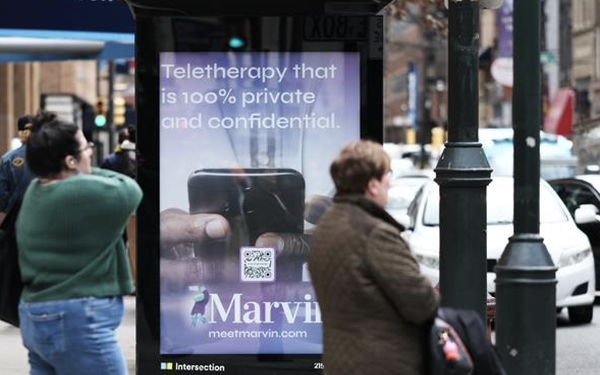Talk To Me Privately: Teletherapy Platform Marvin Targets Healthcare Workers
- by Les Luchter , July 16, 2023

Marvin, which provides a teletherapy platform to hospital systems, has deployed hyper-local bus shelter ads to target its mental health app directly to healthcare workers.
Campaigns to date have used four different out-of-home (OOH) static (printed) ads outside Thomas Jefferson University Hospital in Philadelphia and six different ones outside UCSF Health in San Francisco.
The UCSF campaign in May resulted in a tripling of relevant traffic, and Marvin chief marketing officer Michelle Rider tells Marketing Daily that the brand expects to use similar tactics outside other healthcare partner facilities on a case-case basis.
Ad content has included such messages as “Thousands of healthcare workers have tried talking to someone. Maybe you could too” and “Teletherapy that is 100% private and confidential.”
advertisement
advertisement
The latter is a particularly important point when considering that healthcare workers often shy away from using their own facility’s psychiatric services due to “concerns around confidentiality,” Marvin chief executive officer John Bracaglia tells Marketing Daily. Patients’ info “goes in the medical record that all the rest of the employees can access.”
Marvin launched in 2019, and then got caught in the tailwinds of the pandemic, as the always present mental health needs of healthcare workers “got to a breaking point” and healthcare systems “could no longer ignore it.”
Now, post-pandemic, “We’ve only seen the need for mental health services accelerate,” Bracaglia says. “During the pandemic, there was a lot of support for health workers that helped them battle some of the burnout, but since the pandemic has subsided, people have more time to process a lot of the challenges, such as lack of equipment, so the need is even more acute.
“We’re always seeking to be top of mind for the folks we are marketing to, and these bus ads have been a really nice way to do that.”
The out-of-home campaigns grew out of brainstorming sessions where the Marvin marketing team asked, “How do we talk to people that are only working at this hospital, and not at some other hospital a few blocks away?,” recalls Jared Pyle, manager of growth and analytics “We are working with specific hospitals, so we can’t do a mass campaign.”
Marvin brought in Quan Media Group as its OOH agency, with Quan chief executive officer Brian Rappaport telling Marketing Daily the use of static rather than digital ads gave Marvin “true ownership of the space” versus “having to share space with other brands.”
But the type of ads may change outside other hospitals,” Rappaport says. In Boston, for example, Marvin could use “digital city information panels. One side is a map of the city, the other side is a digital screen where you can run multiple creative messages.”
In other places, where cars predominate rather than buses, this hyper-local approach could use Volta electric vehicle charging stations that include digital ads.
In the meantime, Bracaglia says he was happy, for example, “to find bus stops on the Jefferson campus directly in front of the ER, or directly in from of the employee parking lot. The level of specificity was really important to us.”
Pyle points out that the aim was to reach healthcare workers while they’re commuting -- “when you’re thinking about your day [and] you’re either waiting for that bus that’s running late, or you yourself are running late.
“You may be tired, you may be burned out…but there is a service available to you as a doctor, a nurse, or support staff.”
The San Francisco campaign’s May timing, Pyle adds. “happened to be a quiet period in our marketing calendar” (Marvin’s other marketing tools include email and digital geo-located ads), “so it ended up creating this perfect natural experiment when in the absence of any other activations, we could almost correlate to the day [that the increase] in traffic obviously had to be coming from the campaign that we were running with Quan.”
In addition to traffic increases, other metrics for the campaign included scans of QR codes on the ads (each had a different code to measure the effectiveness of the different copy), visits to the dedicated URL included on the ads, and how much traffic was converted into new signups.


